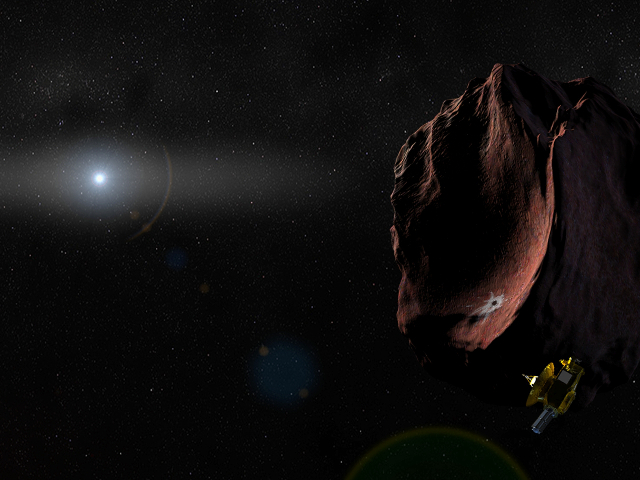
An artist's impression of NASA's New Horizons spacecraft encountering a Kuiper Belt object. [Image Credit: NASA/Johns Hopkins University Applied Physics Laboratory/Southwest Research Institute/Steve Gribben]
Intrepid travelers are always asking the question: ‘Where to next?’ The brains behind NASA’s New Horizons spacecraft are no exception. Having traversed the solar system and completed its main mission of flying by Pluto on July 14, New Horizons is now headed deeper into the Kuiper Belt, a vast region of the outer solar system inhabited by comets, asteroids and other icy bodies known as Kuiper Belt Objects.
The space probe’s destination: a small object called 2014 MU69, roughly a billion miles beyond Pluto. Mission control at the Johns Hopkins University Applied Physics Laboratory altered New Horizons’ trajectory on Nov. 4 in the last of four initial targeting maneuvers aimed at bringing the spacecraft in a close encounter with the small Kuiper Belt Object on Jan. 1, 2019.
![New Horizon’s new target 2014 MU69 lies in the Kuiper Belt, a vast region beyond Neptune’s orbit comprising mostly icy bodies. [Image credit: NASA’s The Space Place a href=”http://spaceplace.nasa.gov/ice-dwarf/en/”]](https://scienceline.org/wp-content/uploads/2015/11/Kuiper-Belt-640x334.png)
New Horizon’s new target 2014 MU69 lies in the Kuiper Belt, a vast region beyond Neptune’s orbit comprising mostly icy bodies. [Image credit: NASA’s The Space Place]
You might be wondering why we should venture to the rather dull-sounding 2014 MU69, a tiny ice ball no more than 28 miles across. It turns out there are three good reasons. The first is that we haven’t done much exploring in the Kuiper Belt. Located just beyond Neptune’s orbit and covering an area 30 to 50 times Earth’s distance from the Sun, the Kuiper Belt has been described as “a large debris field at the edge of the Solar System.”
It has three dwarf planets (Pluto being the most famous) but is mostly dotted with icy bodies, leftover bits from when the Solar System formed. To astronomers, these small bodies are like wooly mammoth fossils found in permafrost — perfectly preserved relics from a distant time. That’s the second reason: MU69 is perfect for studying what the Solar System was like at its birth 4.6 million years ago.
The third is that it won’t take ages to get to, especially when you consider the vastness of space. New Horizons will only have to travel another three years or so to reach MU69, a third of the time it took to reach Pluto from Earth.
2014 MU69 was first observed through the Hubble telescope in June 2014. It was chosen over other candidates because it met all the requirements for a suitable fly-by during the extended New Horizons mission in the Kuiper Belt. Most importantly, it is well within the spacecraft’s range, given New Horizons’ limited fuel supply.
MU69 “costs less fuel to reach, leaving more fuel for the flyby, for ancillary science, and greater fuel reserves to protect against the unforeseen,” said mission leader and planetary scientist Alan Stern in a NASA press release.
New Horizons was never designed with just Pluto in mind — one or two other Kuiper Belt Objects were always in the cards as well. The thinking is a bit like this: If you’ve already driven all the way from New York City to Miami, you might as well go that extra little bit and check out Key West while you’re there. Scientists packed the spacecraft with extra fuel, created a communications system that can transmit messages across vast interplanetary distances and designed scientific instruments capable of capturing images without very much sunlight.
“New Horizons has decades’ worth of exploration left in it,” says Stern.
It’s certainly not the first time a space mission has been extended: the comet-orbiting Rosetta spacecraft was granted another nine months (until September 2016) to explore how a comet’s activity changes as it gets further away from the Sun. Similarly, the Saturn-explorer Cassini had its mission extended twice; instead of ending in June 2008, Cassini will now work until September 2017, allowing scientists to study a complete season on the ringed planet for the first time.
New Horizons’ historic fly-by of Pluto in July was hailed as a great success. For the first time, we have images of the dwarf planet and its five moons that are more than a few fuzzy pixels patched together. The spacecraft has collected so much information that regardless of its mission status, NASA expects to be downloading data for another 16 months.
Although the extended mission has yet to be officially approved by NASA, the New Horizons team had to pick a destination now in order to maximize fuel efficiency. Three earlier adjustments to its trajectory took place between Oct. 22 and Oct. 28. This will set it on track to the most distant object ever explored — a tiny chunk of ice a billion miles past Pluto.
1 Comment
i speculate the Planet Pluto is a “moon and not a Planet whatsoever,but
( the Planet Pluto)that orbits “our” solar Planet #1 , which is a ball of enegery, and not visible, with our presant technogly,
I support our science to make and program a satellite to ride”shotgun” on Pluto’s next return to “see”
where and what it(Pluto) “see” on it’s outer orbit ( our furture tech’s could get more info on pluto odd and strange orbit angle